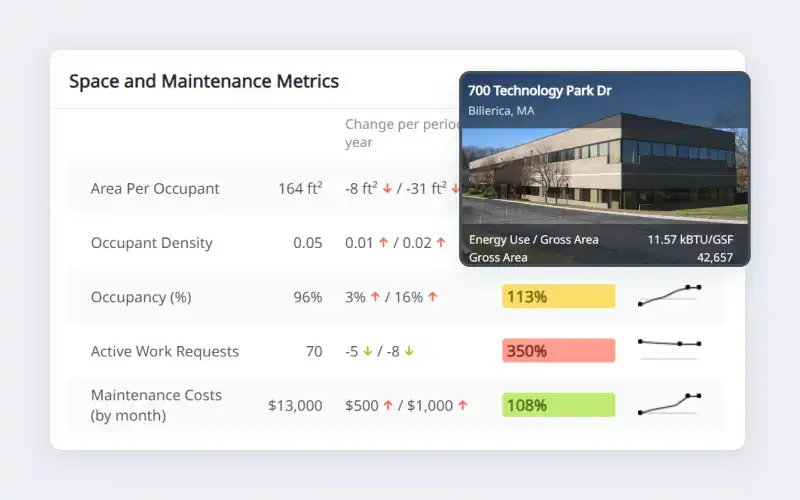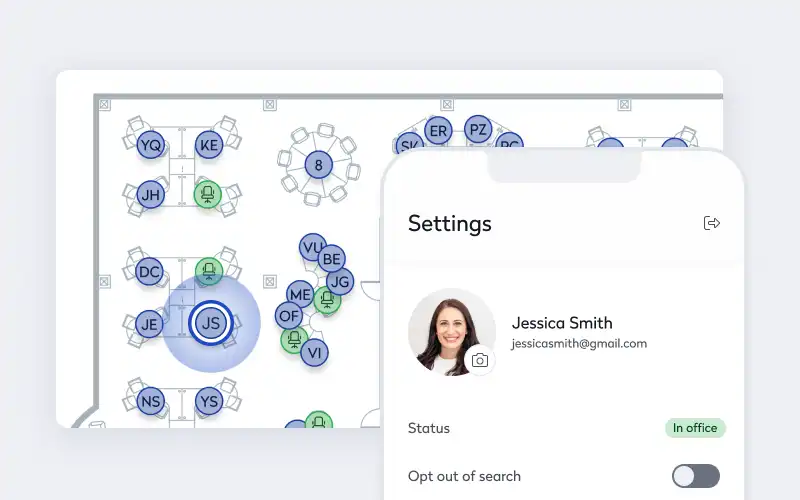
The commercial real estate (CRE) industry continues to evolve based on a core set of trends, including the rise of sustainable office spaces, the growing demand for flexible offices, the adoption of flexible leasing options, the strategic utilization of proptech, and the integration software solutions for enhanced connection and collaboration. By better understanding why and where the market’s moving, businesses can optimize their real estate strategies across their portfolio, gaining a competitive edge.
Continued rise of sustainable commercial real estate
The CRE industry is undergoing a significant shift toward sustainability, as businesses are becoming increasingly aware of the environmental impact of their operations. Enterprise-level organizations are now looking for eco-friendly and energy-efficient spaces to help them meet growing consumer and investor pressure as well as stricter environmental regulations.
Going green also boosts the bottom line. CRE practices can lead to significant cost savings and improved operational efficiency. By reducing energy consumption, water usage, and waste production, businesses can lower their operating expenses and improve their bottom line. Additionally, sustainable CRE practices can enhance employee productivity and well-being, leading to increased employee retention and reduced absenteeism.
And for larger enterprise-level organizations, discovering and implementing a new efficiency has benefits that multiply across the portfolio. It’s simple math. The more facilities you have, the more benefit you get from finding and using a new process or procedure.

Reducing waste can also increase productivity while making it easier to attract and retain top talent. Companies that prioritize eco-friendly practices and sustainable work environments not only contribute to the well-being of the planet but also enhance employee satisfaction and retention. Sustainable workplaces often result in healthier, more productive work environments, which can attract top talent who are motivated by a company’s commitment to environmental responsibility because they feel it reflects their own values.
New places for flexible offices and the hybrid work model
The global market for flexible workspaces is projected to grow significantly, surpassing 40,000 this year, a rapid increase from approximately 27,000 in 2020. Various economic and social factors are driving the change, as companies look for the most economical ways to best meet the needs of their workforces.
Companies have known about the possible bottom-line benefits for years. In fact, a 2019 report by The Instant Group found that companies can save up to 73% of their costs by opting for flexible office spaces over traditional leases. These savings are primarily due to the reduction in operational costs and the flexibility to scale up or down based on business needs.
Over the last five years, social shifts have fundamentally altered the way businesses view their office space requirements. Traditional long-term leases for large, fixed office spaces are no longer the default option. Instead, some companies are opting for flexible office solutions that best support the evolving needs of a more distributed workforce.
Flexible offices, such as co-working spaces, provide businesses with the ability to scale their office space up or down based on demand. This agility allows companies to optimize their real estate costs and avoid being locked into long-term commitments that may not align with their future growth trajectory. Co-working spaces also offer a dynamic and collaborative work environment, fostering innovation and networking opportunities.
The trend towards flexible offices extends beyond traditional co-working spaces. Virtual offices and remote work hubs are emerging as viable alternatives to the traditional office setup. Virtual offices provide businesses with a professional business address and access to meeting rooms and other facilities as needed, without a dedicated physical office.
By embracing flexible office solutions, businesses can potentially gain a competitive edge in the dynamic CRE landscape because they can deliver agility, cost-effectiveness, and employee-centricity. Moreover, flexible offices align with the sustainability trend, as they enable businesses to reduce their environmental footprint and promote a more sustainable work culture.
Flexible spaces and the hybrid work model are not magic bullets, though, and companies need to look at internal dynamics to find the workplace strategies that work best for them and their teams.
Steady shift to more flexible leasing and subleasing
The attraction of flexible leasing is set to continue in 2024. Back in 2020, a survey highlighted that even large enterprises are making the move, with 30% of corporate giants considering or already implementing flexible lease strategies, likely driven by the need for greater flexibility in response to changing business landscapes and economic uncertainty. Smaller organizations did not want to get left behind, and one report in 2021 showed 75% of occupiers prefer lease terms under three years, with the trend particularly pronounced among startups and small businesses, which favor the agility that shorter leases offer.
Businesses are steering away from traditional, long-term leases and embracing flexible leasing options that align with their evolving needs. Short-term leases are gaining traction as companies seek agility in an unpredictable economic climate. These leases offer the freedom to adjust office space requirements quickly, mitigating the risks associated with long-term commitments. Additionally, short-term leases provide companies with the opportunity to test new markets or locations without making significant investments.
Subleasing is another popular flexible leasing option that allows companies to optimize their real estate footprint. By subleasing excess space, businesses can generate additional revenue while reducing their overall occupancy costs. Subleasing also provides companies with the flexibility to expand or contract their office space as needed.
Lastly, the emergence of virtual offices has further expanded the range of flexible leasing options. Virtual offices offer a professional business address and essential services such as mail handling and phone answering, without the need for a physical office. This option is ideal for remote teams or startups seeking a cost-effective way to establish a presence.
By embracing flexible leasing options, businesses hope to achieve greater agility, reduce costs, and enhance their overall real estate strategies. These adaptable solutions can empower companies to navigate the evolving CRE landscape successfully, optimizing their resources and positioning themselves for growth.
Expanding uses for proptech in CRE
Proptech includes a diverse range of technologies, from space management platforms that optimize office layouts to immersive property visualization tools that leverage virtual reality (VR) and augmented reality (AR).
CRE professionals can leverage space management platforms to optimize office layouts, ensuring efficient utilization of space and fostering collaboration. These platforms provide detailed analytics and insights into space usage, occupancy patterns, and employee preferences. By leveraging this data, businesses can make informed decisions about their office design and layout, creating environments that enhance productivity and employee satisfaction.
For example, a company can look at utilization trends for their meeting spaces to fine-tune the office layout. If the company discovers employees are rarely booking the larger boardroom while there are steady reservations for the smaller spaces that better support smaller teams, it can renovate the space, dividing the larger room into two or more smaller, more-in-demand spots.

Proptech also includes IoT sensors and AI-powered predictive analytics that provide valuable insights into building performance, energy consumption, and occupancy patterns. By leveraging this data, businesses can make informed investment and development decisions, optimizing their portfolios and reducing operational costs.
For example, a company might notice a large increase in energy use during the summer months, when the HVAC struggles to keep up with seasonal rises in temperature. From there, they can look at different options, from upgrading the air conditioning to replacing south-facing windows.
VR and AR technologies enable users to virtually walk through properties, explore different layouts, and visualize various design options. This technology enhances the leasing process, reduces the need for physical site visits, and provides a more engaging experience for prospective tenants and investors.
In fact, potential buyers or renters can take virtual tours of properties from anywhere in the world, at any time. Because the technology provides a realistic and immersive viewing experience, clients can more easily visualize the space and its potential without the need for physical visits. Virtual visits are particularly useful in the current economic climate, where many are hoping to cut back on costs, including travel.
Modern worktech that supports connection and collaboration
According to Eptura’s proprietary research on workplace trends in 2024, one of the main drivers for employees wanting to come to the office is the chance to connect and collaborate with colleagues. Many in CRE are now implementing modern worktech platforms that improve the employee experience by streamlining the process of getting into the office and scheduling spaces to work with coworkers.
Automated access control systems and keyless entry enhances security and convenience. A modern visitor management system provides controlled access to authorized individuals, eliminating the need for physical keys and reducing the risk of unauthorized entry. By leveraging these new technologies, the CRE industry is fostering a more collaborative, efficient, and secure work environment, driving productivity and business success.
Inside the office, employees can use the desk booking and room reservation platforms to ensure they have the spaces they need to work. And because they can also see who’s booked the spaces around them, t’s easier to coordinate time in the office for everyone from groups of two to entire departments.
Current CRE trends that move the market
In 2024, several key trends are shaping the CRE industry: the emergence of sustainable office spaces, the increased preference for flexible offices, the adoption of flexible leasing options, the integration of advanced software solutions for better connection and collaboration, and the strategic use of proptech. By staying informed about these developments, businesses can enhance their operational efficiencies and refine their real estate strategies, so they work best for their specific circumstances and business goals.








